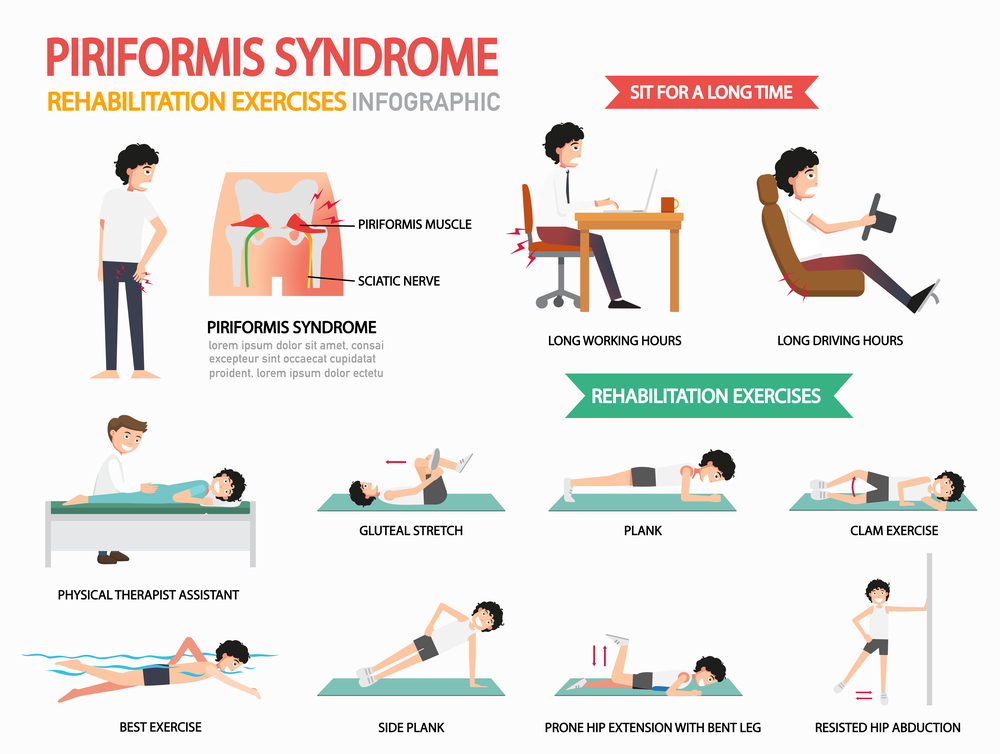Piriformis running injury, commonly known as piriformis syndrome, is prevalent among runners. This injury manifests as discomfort and pain in the buttocks, which may extend down the leg. The root of this issue lies in the piriformis muscle, situated in the buttock area, exerting pressure on or irritating the sciatic nerve.

This issue is particularly common among athletes who run frequently or engage in activities with repetitive leg movements.
Determining the exact cause of piriformis syndrome can be challenging. It’s often linked to factors such as muscle imbalances, overuse, or incorrect form during workouts.
Treatment approaches typically involve a mixture of rest, targeted exercises, and other therapeutic measures. These are designed to relieve pressure on the sciatic nerve and strengthen the surrounding muscles.
Understanding the symptoms and implementing preventative strategies can effectively manage this injury and reduce the risk of its recurrence.
Key Takeaways
- Piriformis syndrome causes pain in the buttocks and leg due to the piriformis muscle impacting the sciatic nerve.
- It can stem from various factors, including muscle imbalances and repetitive motion.
- Effective management includes exercises, rest, and correct workout techniques.
Quick Navigation
Piriformis Running Injury: Understanding Piriformis Syndrome

Piriformis Syndrome is when the piriformis muscle, a small muscle in the buttock region, irritates or compresses the sciatic nerve, causing discomfort and pain. This section will explore the muscle anatomy, the symptoms associated with the syndrome, and the methods used for diagnosis.
Anatomy of the Piriformis Muscle
The piriformis muscle is a small muscle located in the buttock region. It is important for lower body movement because it stabilizes the hip joint and lifts and rotates the thigh away from the body. The sciatic nerve usually runs beneath this muscle. Still, in some people, the nerve can run through the muscles, increasing the risk of piriformis pain due to increased susceptibility to irritation.
Symptoms of Piriformis Syndrome
Individuals experiencing Piriformis Syndrome typically report sciatica-like pain, which includes a dull ache in the buttock area that can extend down the leg, mimicking sciatica. This pain can worsen with activities like running or sitting for long periods. Other common symptoms include:
- Tenderness in the buttock region
- Numbness or tingling along the back of the leg
- Reduced range of motion in the hip joint
Diagnosis of Piriformis Syndrome
Piriformis Syndrome diagnosis typically involves reviewing the patient’s medical history and a physical examination. During the physical examination, the doctor may perform various maneuvers to test for piriformis pain and compression of the sciatic nerve. Imaging tests like MRI may be used to rule out other conditions, but they cannot confirm Piriformis Syndrome directly. Instead, physical symptoms and patient history remain crucial.
Common Causes and Risk Factors

Piriformis syndrome occurs when the piriformis muscle, situated deep in the gluteal region, spasms and irritates or compresses the sciatic nerve. Understanding the main causes and risk factors is crucial for preventing and managing the condition.
Repetitive Motions and Sudden Increases
Many cases of piriformis syndrome are attributed to consistent, repetitive movements, particularly in runners and athletes. This repetition can lead to muscle spasms or swelling in the piriformis, potentially placing pressure on the sciatic nerve.
A rapid escalation in physical activity can also be a significant trigger. When individuals suddenly augment the intensity or duration of their workouts, the sudden increase can overwhelm the hip external rotators, including the piriformis muscle, raising the risk of irritation or injury.
Muscle Imbalances and Overuse
An imbalance in the muscles, specifically in the external rotators of the hip, can lead to compensatory overuse of the piriformis muscle. Over time, this overuse makes the muscle more susceptible to spasms and injuries that can affect the sciatic nerve.
Engaging in activities that overload the glute muscles without adequate rest contributes to overuse injuries. This is commonly seen in athletes who perform extensive lower-body workouts or individuals with occupations requiring prolonged sitting, which can lead to continuous strain on the piriformis.
Treatment Strategies

Effective treatment for piriformis syndrome in runners typically encompasses a multi-faceted approach, balancing pain management with physical therapy to strengthen the surrounding muscles. More advanced options might be considered if initial strategies do not lead to improvement.
Initial Pain Management
For immediate relief from the discomfort caused by piriformis syndrome, runners may find applying a cold pack to the affected area can reduce inflammation. This should be done for about 15-20 minutes every few hours.
In addition to cold therapy, gentle massage with a tennis ball can help alleviate the tension in the piriformis muscle by applying direct pressure and releasing muscle knots.
Physical Therapy and Exercises
Engaging in physical therapy is a critical step towards recovery and prevention of piriformis syndrome. Physical therapists prescribe tailored strengthening exercises to improve the piriformis’ function and the hip complex’s stability.
These exercises normally include a combination of stretch and strengthening regimens that target the piriformis muscle and other hip abductors.
Advanced Treatment Options
Should the pain persist, other treatment options are available. A healthcare provider might prescribe muscle relaxants or anti-inflammatory medications to relieve symptoms.
As a more invasive option, botulinum toxin injections have been shown to effectively reduce pain for patients not responding to more conservative treatments by temporarily paralyzing the overactive piriformis muscle.
Piriformis Running Injury Prevention and Long-Term Care

Preventing piriformis syndrome and ensuring its proper long-term management are crucial to maintaining a runner’s health and performance. Incorporating specific lifestyle adjustments and targeted exercise routines can significantly reduce the risk of developing this painful condition.
Lifestyle Adjustments
Runners should focus on maintaining a well-balanced regimen of physical activity that does not overload the piriformis muscle. Aqua jogging, for instance, can provide a high-intensity cardiovascular workout without the impact on the lower body. This gives the piriformis and other gluteal muscles time to recover from intense land-based workouts.
Additionally, maintaining flexibility through regular stretching and incorporating breaks in seated positions throughout the day can help minimize muscle tightness and nerve compression.
Exercise and Strength Training
To ward off piriformis syndrome, runners should integrate a neuromuscular workout strategy into their routine. This includes exercises that focus on strengthening the piriformis and the surrounding gluteal muscles.
Strength training focusing on the lower body, especially the hips and buttocks, is vital. Effective exercises may include:
- Squats
- Lunges
- Hip thrusts
- Clamshells
Piriformis Running Injury: When to Seek Professional Help

Runners experiencing discomfort in the gluteal region, which may extend down the leg, should be attentive to the duration and intensity of their pain. Persistent or worsening symptoms suggest it’s time to consult a healthcare provider.
- Persistent Pain: A professional assessment is advisable if discomfort persists over several days despite rest and at-home treatments.
- Intensifying Symptoms: Should symptoms intensify, indicating that home remedies are insufficient, you need medical expertise.
A physical therapist or sports medicine expert can provide an accurate diagnosis and tailor a treatment plan specific to the individual’s needs. They offer evidence-based guidance to ensure recovery and prevent further injury.
| Symptoms | Action |
|---|---|
| Constant discomfort | Seek medical advice |
| Pain after rest | Consult a professional |
| Worsening pain | Contact a specialist |
A qualified coach can evaluate an athlete’s running form. This can unearth underlying issues such as muscle-strength imbalances or a leg-length discrepancy. Identifying and addressing these factors is crucial for alleviating piriformis syndrome and fostering a safe return to running activities.
Piriformis Running Injury: Conclusion
Piriformis running injury, or piriformis syndrome, presents a significant challenge for runners and athletes, impacting their performance and quality of life through discomfort and pain in the buttocks and leg.
This condition underscores the importance of understanding the anatomy of the piriformis muscle, recognizing the symptoms early on, and adopting a comprehensive approach to treatment and prevention.
By integrating targeted exercises, rest, and appropriate lifestyle adjustments, individuals can manage the symptoms effectively and minimize the risk of recurrence. Furthermore, seeking professional advice when symptoms persist or worsen is crucial for a tailored treatment plan that addresses the unique needs of each individual.
Ultimately, awareness and proactive management of piriformis running injury can lead to better outcomes, allowing athletes to continue their activities with reduced discomfort and improved overall well-being.

